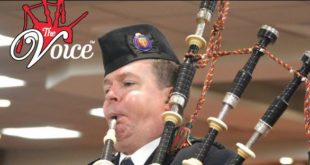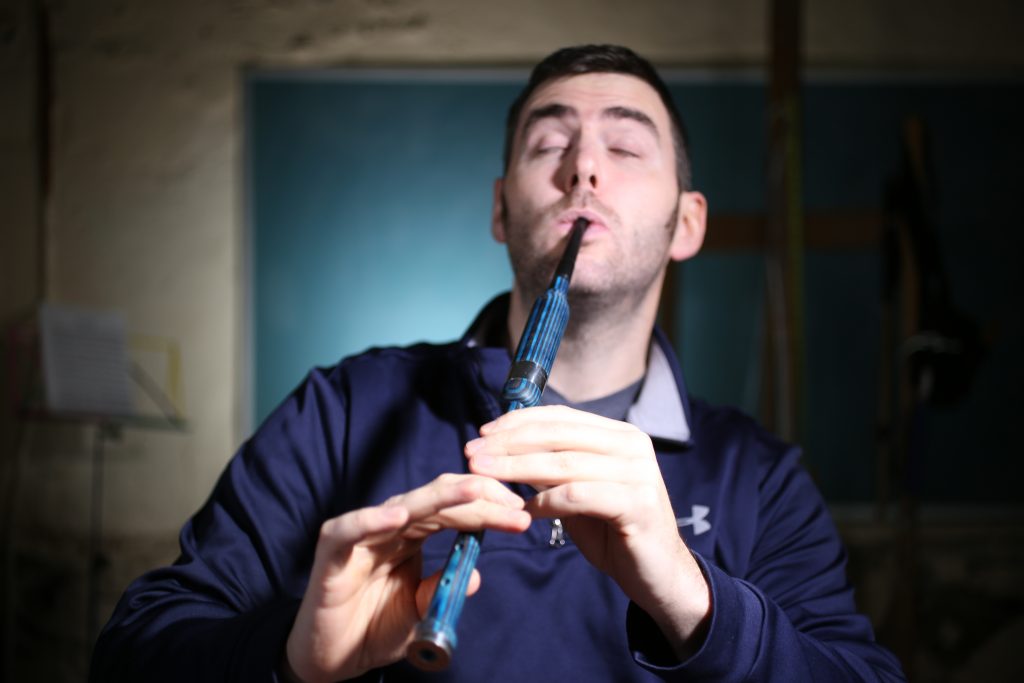A (Controversial?) Blast From the Past

I wrote the article that follows about a decade ago for The Voice Magazine (EUSPBA's quarterly magazine).
It received some criticism from other bagpipe methodologies at the time.
All these years later, I still stand by what I wrote, however, and thought I would re-post this as a great descriptor of what our Piper's Dojo Tutor is all about (and how it can help anyone to learn bagpipes better and faster!).
I started the Piper's Dojo in the summer of 2008 as a year-round local school for bagpipers, with the help and encouragement of Donald Lindsay. Since then, we have expanded by developed a nation-wide online store for bagpipe supplies, an an online "University" for bagpipers.
Even before the Dojo was conceived, I began a side project with the goal of developing a system of learning the pipes that more accurately represented the way that I approach the music and technique. On September 1st (2011), I released the first edition of my new online tutor called "The Bagpipe as an Extension of your Self," which embodies my approach, and offers a distinctly different learning experience than any other "standard" tutor (for example the "Green Book," the Piping Centre tutor, the Logan Tutor, etc) that I am aware of. This isn't to say that these tutors are bad in any way - they just don't represent how I believe bagpipes should be taught.
Flaws in the traditional way of learning the pipes.
Those who have learned from me, perhaps at a workshop or as a member/onlooker to the Oran Mor Pipe Band approach, know that I don't subscribe to the idea of piping as a linear process. For me, the major downfall of this approach - which is uniformly the approach of our standard tutors - is the idea that somehow by adding 'A' + 'B' + 'C' together, these often random finger moves and terminology will eventually turn you into a piper. Music is not about addition to me, but instead about integrating various musical elements.
One of the great ironies I often witness around the games is how the D throw is the least accurately/consistently executed movement by pipers of all levels (including professional level!). It's ironic because this is almost universally the first embellishment pipers learn - it was certainly the first embellishment I learned, as proscribed by the "Green Book." It was only recently, after over a decade of playing at the professional level, with top level bands, that I myself have finally tamed the style of my own d-throw, and am able to do so consistently. Could it be that this movement is introduced to pipers way too early in the learning process?
In the "Green Book," the D throw is introduced in order to learn your first tune, Scots wa' Hae. To me, this creates a loop-hole logically. How is it that we are now learning to embellish something that we haven't even done yet? In other words, the D throw is a finger technique that embellishes a Pipe Tune, but we are learning this without ever having played a pipe tune. How does that work?
The idea behind the Green Book and most tutor books that I have experience with, is to learn things in a certain order (linearly), and eventually you'll come out with a repertoire of basic tunes. However, the "tunes" you've learned have little foundation in musicality; you have only learned to mimic what a bagpiper sounds like. How are you supposed to understand what you are doing? Where are you going to go next?
The Bagpipe as an Extension of your Self
To me, it is this "monkey-see-monkey-do," additive approach to learning and teaching bagpipes that has led to the largely one-dimensional, conformist, un-musical population of players in and about our communities, at all ages and stages. I call this the "you as an extension of your bagpipe" phenomenon. A player goes through the motions, but you does not have any understanding - they are simply an extension of someone else's style, and, while that style may have merit, it is not their voice. In turn, if the music isn't coming from their own "Selves", is it really music?
If they say, "yes, it's music," is it any good? Why wouldn't I just listen to the original? Why wouldn't they? In my opinion, the bagpipe needs to be an extension of your Self, a representation of who you are. A tutor needs to prepare you to make your own musical decisions, and to develop your own style.
Monkeys aren't all bad.
Many peers and colleagues (and possibly you as you read) will say: Andrew, monkey-see-monkey-do is a necessary part of the learning process. In many cases, I agree! I definitely learned much of my basics by "copying" my dad, and later other teachers.
Monkey-see-monkey-do learning happens in a very specific way, which I think even further supports my method. Let's use the example of a young child learning a language (isn't speech mankind's quintessential "instrument?"), and learning largely by copying. If you are encouraging them to speak, what do you start with? Adjectives? Adverbs? I wouldn't. I'd start with Nouns; the simple "identifier" words like Mama, Dada, etc. Pretty soon thereafter you'd need to introduce action words (verbs), but only much later would one need to learn to "ornament" language with adjectives and adverbs. To summarize, yes, successful learning of a language might start by copying. But, you'd start with the simplest elements of the language first, and as you gain more and more experience, you'd begin to add in more layers.
How this method works
In my learning method, the learning path is much the same. It starts with melody notes only, teaches you the basic scale-navigation techniques, and then encourages you to make some simple music using these simple building blocks. In chapter 2, G gracenotes are introduced. After that, supporting gracenotes like D, E and strikes are added (layered) in. As a matter of fact, most of the basic pipe tunes are learned at this point, simply without embellishments.
Only once a piper is successfully making music using these fundamental building blocks do we introduce embellishments. The nature of Embellishments can be seen right in their title: they embellish, or decorate, the music that we play. How can you decorate something that hasn't even been assembled yet? Do you decorate your Christmas tree before you put it on the stand? Before you bring it in the house? How much easier would it be to wait to decorate the tree until it is safely up in the tree stand? Similarly, the learning of the basic bagpipe embellishments is much simpler now that we have the building blocks of bagpipe music under our belts.
Just like learning a language, or even just putting up a Christmas tree, learning the pipes should follow a logical, musical, pathway. That is what the Bagpipe as an extension of your Self is all about. Even if a young child is to learn the pipes by copying - they should do this copying along this logical pathway, that starts with the true basics first, and then builds on that knowledge towards more complexity (and more possibilities).
Take Action
If you're a Dojo student, make sure you've worked your way through our 11 Commandments of Mastery course, and then start looking at our Bagpipe Freedom program.
If you're not yet a Dojo Student, we'd love to welcome you! You can take the 11 Commandments course, which covers the 11 essential mindset tweaks you'll need to prepare yourself for mastery, or explore our monthly membership options and join us as a student, where you can work towards bagpipe freedom in a guided way with hundreds of other pipers around the world cheering you on!






Andrew, I just recently started to take Aikido. In Aikido we have 6 levels before one hits the Black Belt, and another set of levels after that (as high as 10.). All levels prior to Black are simply white belts. During those 6 early levels, we learn the techniques. The focus is on correct footwork, hand movements, being relaxed, all very technical and discreet. Once one hits Black, it is assumed they have conquered to ideas and techniques of Aikido, and can now begin to learn Aikido. The student now has to make Aikido their own ... To compose their movements from the building blocks of the techniques that had masterd in order to respond to whatever situation presents itself ... They need to find their own voice.
Your building block method applies to the first 6 levels in Aikido, in fact I use music as a metaphors to describe what we are doing in Aikido. Getting your voice begins when you no longer have to think about the techniques.
Long response simply to say you are right on ....
I could not agree more.
I've been with Dojo U from the first day and I seriously believed that your teaching method would be embraced worldwide. You are the first person to have made a sensible approach to teaching bagpipes. I had, before I heard you, been making similar suggestions to my pipe major. In the end, I left out of frustration. There are so many people in the bagpipe world who are afraid (?) to link up to the rest of the music world. Seriously - their loss. What's wrong with these people? Please keep doing what you're doing. You've nailed it.
I'd be very interested to read the criticism from that magazine, but I don't have access to it.
I bet there would be a lot more foundation in the music - in the tunes them self - with this approach.
Well, after 40+ years of piping, finally an approach that puts music ahead of technique. Thank you, Andrew. I hope it's not too late for me.
I could remember in my earlier days struggling to get through the tunes, thinking to myself this is how hard it is to play a tune, never mind becoming a musician?? Then I was introduced to this approach through spring training.
Now learning bagpipe music had gone from monkey see monkey do, to actually understanding it and putting the pieces together. As I furthered my journey into piping everything started to come together and make sense.
Andrews way to go about learning the bagpipes makes logical sense, and for those who have struggled with learning the bagpipes, this is a well mapped out way to go about it.
I agree with you 100%. I only wish I could have learned this way 30 years ago. I would be further along in my playing and have a much better understanding of piping music.
Having played other styles of Celtic music I thought it was bizarre that you learn your first tune with embellishments. I hear a lot conformist non-musical playing coming from old style teachers. I can say that because they already hate me for daring to have my own musical ideas. Sean Nos singers are not considered real musicians if they just sound like their teachers.
When I taught ADHD and autistic kids I would change my teaching style to how they learned and would take ideas from anywhere like hunting dog training books and 70's hockey coach seminars. I would communicate with drawing with one and sing with another and had great success. The old school teachers hated this and got me fired. When I found work again 2 years later I bought a practice chanter with my first check.
MMMMM very interesting never saw it that way before, thankyou so much.
Good on you Andrew. I have been feeling the same for years (er, decades actually). Very interesting approach.
I think your article is well written and I wouldn't change a thing. You were not only honest but you never slammed the other styles of teaching. You are just saying there is more than one way to learn pipes and there doesn't have to be just one way. We didn't learn to formulate algebraic equations before we learned the basic math skills. Your approach is excellent and I am an excited to keep learning from the Dojo and to someday call myself a piper.
At age 57 and being a jack-of-all-trades-master-of-none folk musician for over 40 years I argued with my piping teach about this same subject. It just made sense to me to learn the tune first then add the "diddly bits" as I felt comfortable, where he taught the tune with all the extras right from the get go. Way to go Andrew!
My Lord, yes! I had been struggling with D throws etc, for six lessons and nobody had even explained that some notes were longer or shorter than others (dots, etc). I wish my instructors had concentrated on musical basics first. No wonder so many learners give up early.
Andrew,
Great article. I started with the Green Book, as many of us did, and was taught the D throw long before I ever understood the true ornamental nature of the embellishment. From observation and my own play, the typical or traditional teaching methods fail to engrain the importance of the development of true musicality with our instrument. So often you hear pipers sounding terribly robotic or, on the other hand, playing uncontrolled, rushing, crushing, and without a strong fundamental understanding tempo and phrasing.
It seems learning entirely from the traditional way can develop undesirable habits which requires the piper to correct later as they struggle to understand and employ proper musical expression into their "music".
Thank you much for your enlightening article and approach on this critical subject.